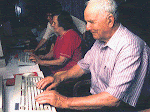 |
| Former subluxation detection dog Barks McCoy on his first day of work after completing Chiropractic College |
Arlington, VA- According to a recent survey published by the American Chiropractic Association, increasing numbers of chiropractors are relying on the services of dogs that have been specially trained to locate abnormalities in the spine.
Prince, a hulking black and tan Doberman Pinscher, is led around a state of the art chiropractic examination room at the underground headquarters of the American Chiropractic Association in Arlington. He saunters past an array of diagnostic tools, handheld spring-loaded treatment devices and a poster of a kitten hanging from a tree branch that reminds these chiropractic researchers to "hang in there." He approaches a group of ten men, only one of which has been legally diagnosed with a subluxation, a complex of functional and/or structural and/or pathological articular changes that compromise neural integrity and may influence organ system function and general health that is the primary concern of licensed chiropractors.
The proud and noble canine circles the men, occasionally emitting a low pitched growl and stopping to sniff a seemingly random crotch. But Prince's crotch sniffing is anything but random. His nose, and the noses of dogs like him according to ACA researchers and thousands of practicing chiropractors around the country, can detect subluxations with far greater sensitivity than even the most high tech devices. Prince suddenly stops in front of one of the subjects and vocalizes a single but purposeful bark. He's made his choice, the correct one, and is soon rewarded with a small chunk of beef jerky.
"Prince is never wrong," Lead researcher Chiropractor Gerald Gravy explains. "It's uncanny. Even when he picks a subject that wasn't originally found to have a subluxation, we check again and there it is. That tells us he is able to detect them even in their earliest stages."
Once dogs like Prince first demonstrated their ability to detect even the most subtle of subluxations, likely via nanosensing or energy vibrations or some shit, reports came into the ACA of dogs without specialized training having similar success. Although the ACA continues to claim that their certified specially bred and trained dogs represent the pinnacle of subluxation detection, and can be rented from the organization for a few thousand dollars a month, the sheer number of anecdotal success stories pouring in from community chiropractors from Seattle to South Portland, which is in Maine and on the complete other side of the country from Seattle, has forced an official admission that pretty much any dog can successfully sniff out these silent and often symptomless spinal whatchamacallits.
"Frankly none of this should come as much of a surprise," Madington Crump, an Arlington area chiropractor and owner of the popular holistic gluten-free bakery and flower shop Pastries and Peonies, revealed. "Dogs have been used to detect a variety of cancers, predict seizures and even respond to diabetic emergencies. Subluxations are every bit as not made up as those conditions."
What unique aspect of human pathophysiology are these dogs detecting? So far there are only theories. Conventional researchers have dedicated their careers to solving the enigma of canine cancer detection, and have even narrowed the potential source down to a handful of chemical biomarker candidates using advanced spectrometers and chromatographs. But researchers like Chiropractor Gravy are wary of becoming too focused on explanations. "We've got a really good thing going here. Our customers are satisfied. Kids like the dogs. We start offering a Diplomate course in Canine Subluxation Detection in January."
Prince is oblivious to the machinations of the chiropractic community. After nearly a decade of identifying subluxations for the ACA team, he has earned the kind of respect most dogs only dream of. He prances around the facility as if he owns it, which is absurd because at the time of this posting Prince only owns 25% of the company's voting stock shares.





